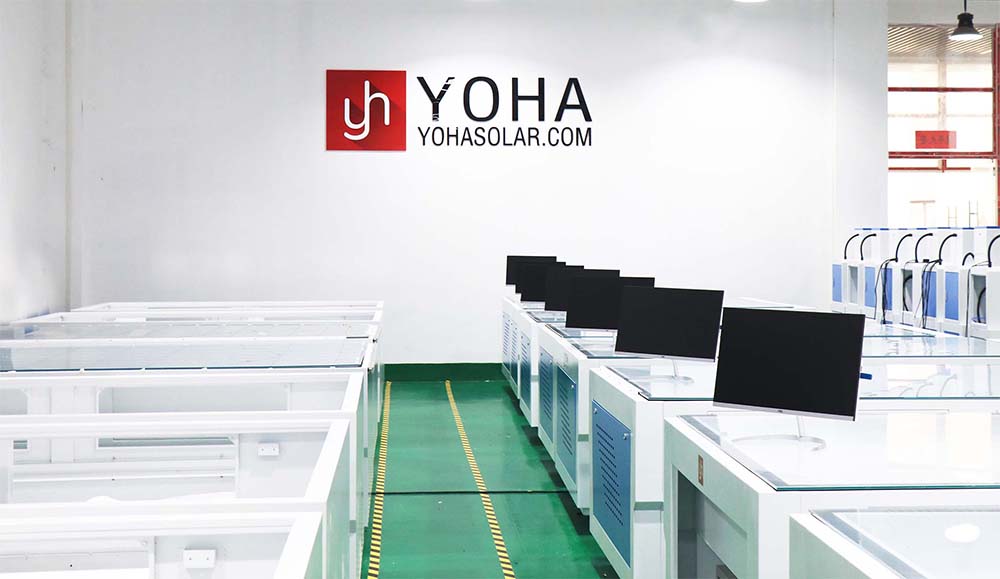Welcome to Wuhan Yoha Solar Technology Co., Ltd!
common problem
Site Map
Language:
 Chinese
Chinese
 English
English
Welcome to Wuhan Yoha Solar Technology Co., Ltd!
common problem
Site Map
Language:
 Chinese
Chinese
 English
English
In the manufacturing process of photovoltaic (PV) modules, the production line module electroluminescence (EL) tester and analyzer has become a core inspection tool for ensuring product quality. As an indispensable quality control step in PV module production lines, EL testing technology enables non-destructive detection of internal defects in modules, providing an intuitive and reliable inspection method for process quality assurance. This article comprehensively analyzes the technical principles, core functions, and critical role of production line module EL testers and analyzers in PV manufacturing.
The production line module EL tester and analyzer operates based on the principle of electroluminescence. When a forward bias is applied to a PV module, electrons and holes recombine at the PN junction, releasing photons. A high-sensitivity camera captures these faint luminescent signals to form an EL image. High-quality solar cells appear as uniform bright areas in the EL image, while defective regions exhibit distinct dark spots or abnormal patterns.
Modern production line module EL testers and analyzers use high-resolution CCD or CMOS sensors combined with precision optical systems to clearly capture subtle luminescence variations within modules. The equipment is typically equipped with an auto-focus system and multi-spectral filters to accommodate different types of PV modules. In a production line environment, the EL tester must have rapid response capabilities, often completing a full inspection of a standard module within seconds.
Advanced image processing algorithms are one of the core technologies of production line module EL testers and analyzers. Through intelligent analysis of EL images, the system can automatically identify various defect characteristics, such as micro-cracks, broken grids, cell fragments, and poor soldering, while quantifying defect severity to provide an objective basis for quality grading.

The production line module EL tester and analyzer is equipped with multiple key functions, making it a critical safeguard for PV module quality control. The primary function is defect detection and classification. The device can automatically identify various defects in modules—such as micro-cracks, fragments, black cores, and broken grids—and classify them according to predefined standards, with each defect exhibiting unique characteristics in EL images.
High-precision image acquisition is the foundational function of the production line module EL tester and analyzer. The device employs high-sensitivity sensors and low-noise electronic design to capture clear EL images even under weak luminescence conditions. Multi-frame stacking and noise reduction algorithms further enhance image quality, ensuring reliable detection of even the smallest defects.
Automated analysis and evaluation significantly improve EL testing efficiency. Modern production line module EL testers and analyzers feature built-in intelligent image processing software that automatically measures cell luminescence uniformity, calculates defect area ratios, evaluates defect distribution, and generates standardized quality assessment reports. This quantitative data provides clear direction for process optimization.
The production line module EL tester and analyzer also includes data management and traceability functions. All test results are stored and linked to module serial numbers, establishing a comprehensive quality database. Through data analysis, systematic defect patterns in production can be identified, enabling early warnings and rapid troubleshooting of quality issues.
Compared to traditional inspection methods, the production line module EL tester and analyzer offers significant technical advantages. Non-destructive testing is its most prominent feature—the inspection process does not damage the module, enabling 100% full inspection and greatly improving the reliability of finished products.
High detection sensitivity is another major advantage. Modern devices can detect micron-level micro-cracks and tiny defects, far exceeding the capabilities of manual visual inspection. This high sensitivity ensures potential quality risks are identified early, preventing defective products from moving downstream.
Rapid inspection capability allows the production line module EL tester and analyzer to seamlessly integrate with production line rhythms. Optimized optical systems and efficient image processing algorithms enable the inspection of a single module to be completed in seconds, achieving comprehensive quality control without disrupting production efficiency.
High level of intelligence is a common feature of modern production line module EL testers and analyzers. Deep learning-based defect recognition algorithms continuously evolve, automatically learning new defect patterns to improve detection accuracy. Additionally, the equipment features self-diagnosis and calibration functions to ensure long-term stable testing performance.
In PV module production workflows, the production line module EL tester and analyzer is typically deployed at multiple critical stations, serving different quality control purposes. After cell string soldering, EL testing can promptly identify issues such as poor soldering or micro-cracks, preventing defects from propagating to subsequent processes. Pre-lamination testing detects mechanical damage caused by handling or operations, providing feedback for process improvements.
Post-lamination EL testing is one of the most critical inspection stages in PV module production. A comprehensive inspection at this stage evaluates all defects accumulated during the manufacturing process, serving as the basis for final quality grading. The efficient operation of the production line module EL tester and analyzer ensures consistent quality in finished products.
The vast amount of quality data collected by the production line module EL tester and analyzer serves as a valuable resource for process optimization. By analyzing defect types and distribution patterns, root causes—such as raw material defects, improper equipment parameters, or operational errors—can be traced, enabling targeted process improvements and continuous yield enhancement.
In the development of new PV technologies, the production line module EL tester and analyzer also plays a vital role. By comparing EL image characteristics under different process conditions, researchers can visually assess the impact of new technologies on module reliability, accelerating the industrialization of innovative solutions.
With advancements in PV manufacturing technology, production line module EL testers and analyzers are evolving toward greater intelligence and efficiency. Deep integration of AI technology will be a key focus for future upgrades. Deep learning algorithms will enhance defect recognition capabilities, enabling automatic detection of new defect patterns and prediction of potential quality risks.
High-speed, high-resolution imaging technology will continue to advance. Future production line module EL testers and analyzers will further reduce inspection time while maintaining or improving image quality to meet increasingly demanding production line speeds. Larger sensors will allow single-shot imaging of larger module areas, minimizing efficiency losses from image stitching.
Multi-technology fusion inspection will become a key trend. Combining EL testing with photoluminescence (PL), infrared thermography, and other techniques will create a multi-dimensional module quality assessment system, offering more comprehensive defect analysis. This integrated approach cross-validates results, improving defect identification accuracy.
Cloud-based data analysis and remote diagnostics will be enhanced. Future production line module EL testers and analyzers will be deeply integrated into industrial IoT systems, enabling real-time data uploads and centralized analysis. Expert systems will remotely monitor equipment status, providing fault warnings and maintenance recommendations to minimize downtime.
As a critical component of smart PV manufacturing, the technological level of production line module EL testers and analyzers directly impacts the reliability of final products. As PV modules evolve toward higher efficiency and larger formats, EL inspection technology will continue to innovate, providing robust support for quality advancements in the PV industry. Selecting high-performance production line module EL testers and analyzers and establishing a comprehensive quality inspection system are essential steps for PV manufacturers to enhance market competitiveness.
keywords:TOP
18086473422
MESSAGE
